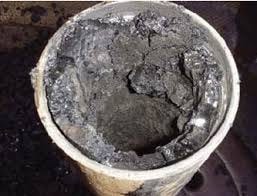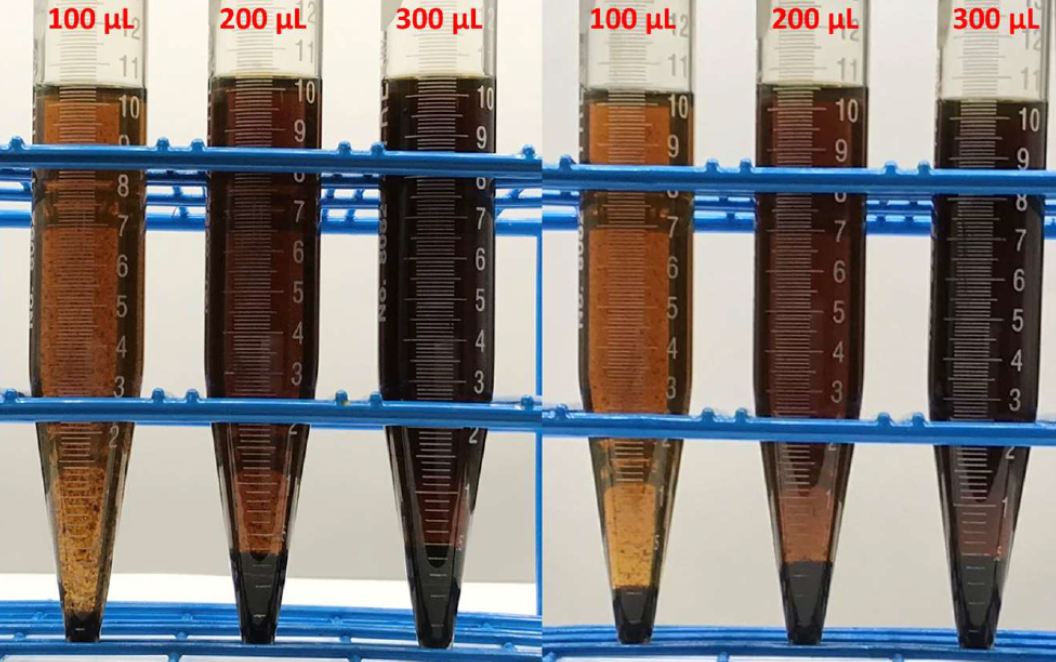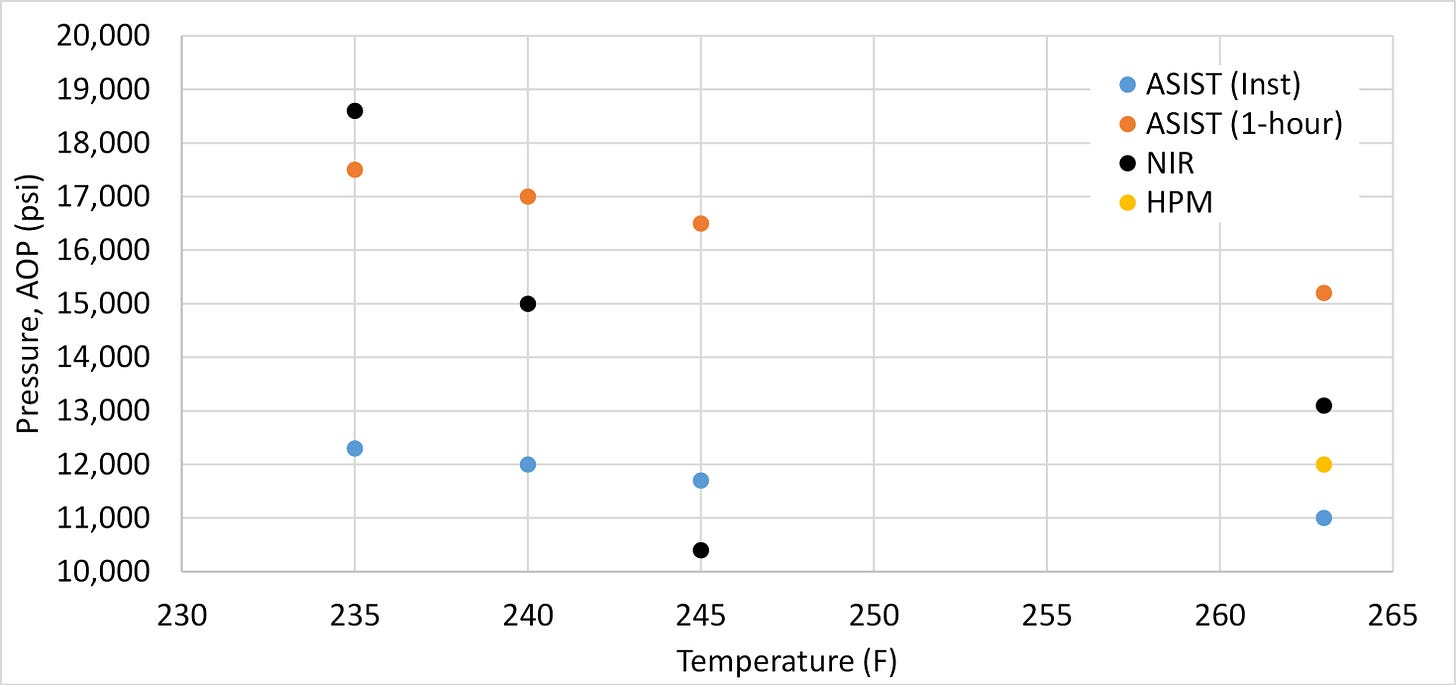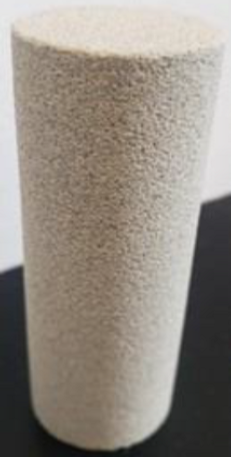Asphaltenes and Gas Injection
A “How to” Guide on using coreflooding to determine asphaltene stability
Going by our numerous posts on hydrates, wax, asphaltenes, inorganic scaling, emulsions and the use of production chemicals. I think by now you probably know that we love all things Production Chemistry related at Pontem Analytics. So it is not too surprising that we are going back to one of our favourites, asphaltenes.
If you want even more information on asphaltenes have a look at one of our other past posts.
So let’s reacquaint ourselves with Asphaltenes. These are a particularly messy solid associated with oil production that can drop out into your system all the way from the reservoir to your processing facility. Below is an example of the headache that you sometimes have to deal with when it comes to asphaltenes.
The term asphaltenes was coined in 1837 by a French scientist however it wasn’t until the 1930’s that it was realized they were in many hydrocarbon-based products, not just crude oil, such as bitumen, tar and naturally occurring asphalts.
The asphaltene fraction of a crude oil is usually defined as the heavy polar aromatic part that is soluble in hot, aromatic solvents such as toluene, but insoluble in normal alkanes such as n-heptane. From a chemical structure perspective these are big, complicated molecules and when they drop out they can quite easily block well tubing / piping / separators. The picture at the start is a good example of that.
The Problem at Hand
Asphaltenes are of interest to Pontem as the characterization of asphaltenes stabilities is one of the main areas of analysis to be performed when developing flow assurance strategies for new black oil developments.
For this post, the focus is on a deepwater field where we have assessed the impact of potential asphaltene deposition in both the development’s production and gas injection systems. It is fairly standard to look at asphaltene instability and deposition when designing new production systems but our approach is a less common method to evaluate: via the use of a coreflood to determine what might happen if you inject gas into a reservoir containing oil. Performing a coreflood is an expensive and lengthy process, so is only performed when specifically required to fit the needs of the project.
When looking at characterizing whether a production system is likely to have an asphaltene problem there are a number of analyses that can be performed. These replicate very well the chemical interactions and kinetics of asphaltene deposition in a conventional oil production system. For the field in question we performed an extensive suite of tests, which included:
SARA analysis – This was performed to determine the concentrations of (S)aturates, (A)romatics, (R)esins, and (A)sphaltenes in the oil. Once obtained the combination of saturates and asphaltenes when compared with the Resins and Aromatics can help determine the potential instability of the oil by comparing it with a wide range of oils with known asphaltene instabilities.
Asphaltene Screening Tests – Firstly, this test can be used to estimate the presence of asphaltenes in a crude oil sample and secondly to determine the propensity of the asphaltenes to precipitate when exposed to destabilizing conditions (namely, a flocculant in this test). This is done by diluting a small amount of oil into excess heptane and forcing any asphaltenic compounds in the fluid to precipitate, providing a relatively quick method to screen oils.
Live Oil Thermal Depressurization – These tests on live oil samples using an isothermal depressurization rate determine the Asphaltene Onset Pressure (AOP). The test utilises pressurized samples that are restored to reservoir conditions prior to a stepwise depressurization at constant temperature with a set equilibrium time between each decrease in pressure. At each pressure step, light transmittance through the sample is measured via near infrared spectroscopy (NIR). A sudden decrease in light transmittance would be indicative of asphaltene precipitation.
In addition to NIR, the sample is viewed using high pressure microscopy (HPM) for any visible asphaltene flocculation or other particles at each pressure step.
Asphaltene Stability Trend (ASIST) – This method was developed by the New Mexico Institute of Mining and Technology and their collaborators, and it has led to a more accurate method for asphaltene screening versus conventional industrial screening methods (e.g. live oil isothermal depressurization). This method is known as the ASphaltene InStability Trend (ASIST). The ASIST method utilizes asphaltene-specific laboratory testing results to account for the differences in the asphaltene stability characteristics for different oils. The ASIST model has generated increasing interest in the flow assurance industry, and it has been applied during multiple petroleum developments to address asphaltene concerns in the field.
The advantages of ASIST modelling versus live oil testing are:
Less oil volume is required to carry out the testing
ASIST modelling is performed with dead oil rather than limited live oil samples
Mixing of oils is easier with ASIST; minimal extra work / testing is required for mixing
The ASIST calculation estimates asphaltene instability in produced oil at various pressures and temperatures based on measurements using stock tank oil. The method combines
Reservoir PVT data
Fluid compositions and thermodynamic properties
Differential liberation results
Pressure, corresponding formation volume factor, and gas/oil ratio
Data from stock tank oil asphaltene instability experiments
Refractive index of the oil, (RI)
Refractive index of the oil at the onset of asphaltene precipitation using a flocculating agent such as n-C11, n-C15, (PRI)
One of the more interesting outcomes of ASIST testing that Pontem have been involved in is the Kinetic effects and the impact of ageing of the oil and how that impact asphaltene stability. Especially from an ageing perspective the graph below shows how just a 1 hr difference impacted the results of the ASIST evaluation.
If you want to delve a bit deeper into what ASIST is all about check-out one of our other posts.
Gas Injection Effect using a High-Pressure Rheometer - Compositional changes in the production fluids due to gas injection or gas lift can negatively impact asphaltene stability and induce solids precipitation. The light ends present in the gas can cause otherwise stable asphaltenes in the production fluid to precipitate.
High-pressure (HP) rheometer tests were conducted to assess the potential increase of asphaltene deposition risks caused by gas injection in the reservoir. These tests evaluate the risks of asphaltene deposition at reservoir-like conditions over a 7-day period. The experimental gas-to-oil ratio (GOR) was adjusted to 2715 scf/stb by adding a formulated solution gas. Mixing shear rate was set to 150 s-1.
The picture to the left shows what no asphaltene deposition looks like and the one on the right shows asphaltene deposition on the side of the vessel and the stirrer.
For the oils evaluated, the results looked like the picture on the left.
Taking into account all of the results from the various test methods employed. There was no indication of any significant risks from asphaltene deposition / instability when producing oil into the subsea and topsides production facilities. The issue here is that the residence time of the oil in such a system is likely to be in hours / days not weeks or months. Consequently, some other form of testing needed to be performed to help us understand better the long term impact of the destabilizing effect of gas injection into a reservoir containing oil. Pontem knew this couldn’t been done by the initial set of testing that was performed so we developed a test protocol that would replicate better this process. This is where the use of a coreflood rigs comes in handy.
Gas Injection Coreflood Tests
Although the previous gas injection test replicated the GOR, temperatures and pressures expected during the gas injection process there was no asphaltene deposition over a period of 7 days. However we knew from our previous experience that there were a few more bases to cover. So we identified a test method that would better replicate the kinetic and ageing effects that would occur with gas injection into an oil bearing reservoir. That test method was the use of a High pressure / High Temperature. By doing this we were able to extend the actual rock / oil / gas contact times to a minimum of 30 days and replicate how the injected gas would interact with the oil in the actual reservoir.
These tests are not performed very often due to the sophisticated and costly experimental coreflooding equipment required to replicate the temperature and pressure conditions expected in the reservoir rock. A picture of the coreflood rig used can be seen below.
The equipment used for this testing is what you would call “state-of-the-art” coreflooding and measuring equipment. This equipment does not come cheap as the best ones are made out of very expensive metal alloy (e.g. Hastelloy 276) situated in a large walk-in oven holding a coreholder (see below) that is fed liquid and gas via pumps located outside of the oven.
For these types of tests, ideally you have core plug samples of the actual rock where the oil sits but in this instance these were unavailable. Therefore, Pontem using our knowledge of core analysis were able to source sandstone rock samples with similar permeability and porosity as the rock found in the Trion reservoir formation. Once you have the “surrogate” rock samples there is still quite a bit that still needs to be done to condition the core plug samples in preparation for the tests. This includes the cleaning and then the analysis of the rock samples to get their porosity and permeability. The cleaning process can take days to complete depending how dirty the core samples are.
The cleaning process involves continually soaking the core plug in hot toluene and methanol to remove all organic material from the plugs. The equipment required for this can be seen below:
Once cleaned and dried the core plugs looked like the picture below:
With it being nice and clean and all the pores in the rock being empty, the core plug samples were ready to get their porosity measured using X-ray Tomography. X-ray tomography emits a 3D cone of X-ray irradiating on a rotating specimen to characterize porosity defects based on the density discrepancies among diverse phases, which enables reconstructing pores' detailed information, including size, shape, distribution, etc.
Why is porosity important? The reason you need to know the porosity of the rock is because it tells you how much oil can be in the rock (i.e. pore volume) and also you need to know how well connected the pores are because if the pores are not connected then the oil won’t flow.
The following is a picture of the top of the cores showing the microstructure of the axial cut of the rock sample.
From the X-Ray Tomography of the core samples we were able to generate a 3D model showing the Total Porosity, Effective Porosity and Isolated Porosity
The porosity data obtained can be found in the following tables:
Running the Tests
After we had cleaned the core plug sample and measured its porosity. The test was ready to go. All we had to do was place the core plug sample in the coreholder and insert into the coreflood rig.
Once in the rig, the premise of the test was fairly simple. We would saturate the core plug in the coreflood rig with crude oil by pumping oil through the plug until the full plug was filled with oil. Then synthetic natural gas was injected into the plug to see if it destabilized the crude. The core was then shut into the coreflood rig with gas and oil present and left for 30 days to see if over time asphaltene destabilization occurred.
There were a number of measurements that were needed to be taken. These were:
1. Absolute permeability of the core sample to oil only
2. X-Ray Tomography of the core plug before and after gas injection and the 30 day shut in period
3. The asphaltene content in the oil before and after gas injection and the 30 day shut in period by doing a SARA analysis
4. Effective gas permeability and gas/oil relative permeability before and after gas injection and the 30 day shut in period
The above tests were performed using two different types of crude oil; Sample Oil A and Sample Oil B. Each crude oil had a new clean core plug for testing.
Darcy’s Equation
When it comes to core flooding or more importantly the production of oil and gas from a reservoir formation, one of the most important parameters is the permeability of the rock (i.e. in layman’s terms “how easy it is for oil, gas or water to travel through a rock”). The go-to equation when calculating the permeability of a rock is Darcy’s Equation.
Where:
q is the fluid flow rate in units of cm³/min.
μ is the fluid viscosity under operating conditions in units of cP.
L is the length of the porous media in mm.
A is the cross-sectional area of the porous media sample in cm².
ΔP is the pressure difference between the inlet and outlet of the porous media in psi.
K is the permeability in millidarcies.
The information required for this particular test to allow us to determine the rocks permeability can be found below for both fluids tested.
SARA Analysis
To determine whether asphaltenes dropped out in the test. It was important to measure the asphaltene content before and after the injected gas was mixed with the oil and left at reservoir conditions for 30 days. Consequently, the oil used was analyzed to determine the Saturates, Aromatics, Resins and Asphaltenes (SARA) ratio of the oil before it was added to the core plug to get a baseline for the oil before the asphaltene deposition test was performed.
Outcome of the gas injection corefloods
With all the previous laboratory studies not showing any significant asphaltene instabilities it was important to see if gas injection and a 30 day aging period for the oil made any significant difference to the asphaltene stability of the oils tested. The results of the tests performed can be found in the Table below:
So what does it all mean?
When it comes to evaluating the above results, it can be seen that for Sample Oil A the level of asphaltene deposition is negligible considering the actual amount of asphaltene that has deposited rather than the % decrease. In fact, the Relative Gas Permeability of the core plug actually increased so there has been minimal, if any asphaltene deposition that has blocked up the pores of the core plug. So nothing needs to be done when injecting gas into a reservoir rock containing Sample Oil A.
As for Oil Sample B the story is different. With a higher level of asphaltene content there has been a noticeable decrease in the Relative Gas Permeability indicating asphaltene deposition in the core plug after the 30-day aging period.
So what does that mean in reality and was it a showstopper? Although there is an indication that over longer periods asphaltenes were dropping out of Oil Sample B in the rock, the overall impact of injecting gas into a reservoir rock full of Sample Oil B is manageable.
Also worth mentioning, that if the gas being injected is into a non-oil bearing rock, then this becomes a non-issue.
More importantly, what the coreflood work has shown is that if you don’t have an in depth understanding of all the various issues, it is a difficult to design the right testing program. If Pontem had stuck with the standard laboratory test methods we initially employed we may not have identified the potential risks associated with gas injection in this application. Without being able to identify that there is an actual risk, it becomes difficult if not impossible to find a way to manage those risks.
What does Manageable look like?
With any injection well whether it is gas or water and there is a concern that solids may drop out. The primary aim is to make sure that any deposition does not occur in the near wellbore area of the injector. This is because at the near wellbore there is a limited flow area that the gas in this instance can flow through, so any restriction there will have an oversized effect. Once deep into the reservoir, deposition may still occur but due to the near unlimited flow paths the gas could take, the ability to inject the gas should be unimpaired.
Taking this into account, to remove the small risk of asphaltene deposition while injecting gas into the oil-bearing rock you push the oil away from the near wellbore area of the gas injection well. By doing this you push the oil so far into the rock that any deposition that occurs will have a negligible impact on gas injectivity.
Now you are probably wondering how this can be done. Fortunately, there is a tried and tested method for doing this. When required, the preferred option is to perform a “mutual solvent squeeze”. If you are not familiar with the terms, a “mutual solvent” is a solvent that has good oil and water solubility and a “squeeze” is an oilfield term for when a liquid is pushed into an injection or production well to enhance injection or production. It works by either pushing the incumbent fluid away from the near wellbore area or it introduces a chemical in the near wellbore area. If there is no oil to mix with the injected gas at this point then asphaltene deposition can’t occur. In this particular occasion, the mutual solvent acts as a buffer between the oil and the gas at the near wellbore ensuring that there is no deposition in the area that would be most detrimental to gas injectivity.
Even if you don’t do the mutual solvent squeeze and you get asphaltene deposition. Don’t worry all is not lost. There are numerous solvents that can be squeezed into the near wellbore area to dissolve any asphaltene that may have deposited. These are more commonly known as “asphaltene dissolver squeeze treatments”. Probably should also say that this is a different type of chemistry to the mutual solvent and is performed successfully all around the globe.
Finally, I think what this shows is that for most things there are various ways to identify problems but where you need to be clever is finding solutions and that is where Pontem Analytics comes in. With all the experienced SME’s we have onboard we have 100’s of years of accumulated experience to help identify not only your problems but more importantly your solutions.





















